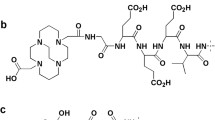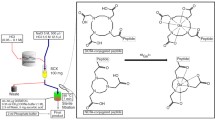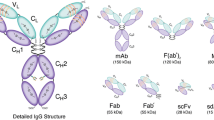Abstract
Purpose
The success of 68Ga-labeled peptides for positron emission tomography of neuroendocrine tumors is mainly depending on the complex chemistry of this radioisotope. 1,4,7,10-Tetraazacyclododecane-1,4,7,10-tetraacetic acid (DOTA), the chelator of choice has however limitations if its application is expanded to heat-sensitive proteins. Recombinant antibodies like single chain Fv or diabodies belong to this class of proteins. They are suited to provide imaging contrast despite the short-lived 68Ga because of their rapid blood clearances and nanomolar affinities. The heterobifunctional agent N,N′-bis[2-hydroxy-5-(carboxyethyl)benzyl]ethylenediamine-N,N′-diacetic acid (HBED-CC) was chosen as an alternative ligand because this agent is complexing [68Ga]Ga3+ much faster than DOTA at ambient temperatures.
Materials and methods
A versatile technology for HBED-CC conjugation of proteins and 68Ga-labeling has been developed. This included HBED-CC–tetrafluorophenol (TFP) ester synthesis, coupling to the antibody at various pH and complexation reactions performed in 4-(2-hydroxyethyl)-1-piperazineethanesulfonic acid (HEPES) buffer under different conditions.
Results
The synthesis of the monoreactive 2,3,5,6-tetrafluorophenolate of HBED-CC at a carboxyl group not participating in complex formation used [Fe(HBED-CC)]− for ester formation. The removal of Fe3+ from purified (HBED-CC)TFP ester was achieved with RP18 cartridge technology. The conjugation chemistry was performed with mAb425 which binds to the epidermal growth factor receptor (EGFR). This protein was used for optimizing purposes only. The influence of complexation parameters like temperature, pH, reaction time, and HBED-CC/antibody ratio on the biological activity of this model antibody was investigated. Furthermore, the outcome of this labeling procedure on the biological activity of a recombinant diabody (50 kDa) was studied.
Conclusion
It is known that small HBED-CC/antibody ratios are prerequisites for minimal interference of labels with antigen-binding domains. Here, the coupling of about one HBED-CC per antibody proved to be sufficient for efficient 68Ga labeling, pointing to the successful application of 68Ga for molecular imaging with small recombinant proteins.







Similar content being viewed by others
References
Maecke HR, Hofmann M, Haberkorn U. 68Ga-labelled peptides in tumor imaging. J Nucl Med 2005;46(Suppl 1):172–8.
Smith-Jones PM, Solit DB, Akhurst T, Afroze F, Rosen N, Larson SM. Imaging the pharmacodynamics of HER2 degradation in response to Hsp90 inhibitors. Nature Biotechn 2004;22:701–6.
Heppeler A, Froidevaux S, Maecke HR, Jermann E, Béhé M, Powell P, et al. Radiometal-labelled macrocyclic chelator-derivatised somatostatin analogue with superb tumour-targeting properties and potential for receptor-mediated internal radiotherapy. Chem Eur J 1999;5:1974–81.
Lewis MR, Raubitschek A, Shively JE. A facile, water-soluble method for modification of proteins with DOTA. Use of elevated temperature and optimized pH to achieve high specific activity and high chelate stability in radiolabelled immunoconjugates. Bioconjug Chem 1994;5:565–76.
Smith-Jones PM, Vallabahajosula S, Goldsmith SJ, Navarro V, Hunter CJ, Bastidas D, et al. In vitro characterization of radiolabelled monoclonal antibodies specific for the extracellular domain of prostate-specific membrane antigen. Cancer Res 2000;60:5237–43.
Schuhmacher J, Matys R, Hauser H, Maier-Borst W, Matzku S. Labelling of monoclonal antibodies with a 67Ga-phenolic aminocarboxylic acid chelate. Part I. Chemistry and labelling technique. Eur J Nucl Med 1986;12:397–404.
Mathias CJ, Sun YZ, Welch MJ, Connett JM, Philpott GW, Martell AE. N,N′-bis(2-hydroxybenzyl)-1-(4-bromoacetamidobenzyl)-1,2 -ethylenediamine-N,N′-diacetic acid: a new bifunctional chelate for radiolabelling antibodies. Bioconjug Chem 1990;1:204–11.
Schuhmacher J, Klivenyl G, Hull WE, Matys R, Hauser H, Kalthoff H, et al. A bifunctional HBED-derivative for labelling of antibodies with 67Ga, 111In and 59Fe. Comparative biodistribution with 111In-DTPA and 131I-labelled antibody internalizing and non-internalizing tumors. Nucl Med Biol 1992;19:809–24.
Schuhmacher J, Maier-Borst W. A new Ge-68/Ga-68 radioisotope generator system for production of Ga-68 in dilute HCl. Int J Appl Radiat Isot 1981;32:31–6.
Kipriyanov SM, Little M. Generation of recombinant antibodies. Mol Biotechnol 1999;12:173–201.
Kipriyanov SM, Kupriyanova OA, Little M, Moldenhauer G. Rapid detection of recombinant antibody fragments directed against cell-surface antigens by flow cytometry. J Immunol Methods 1996;196:51–62.
Kipriyanov SM, Moldenhauer G, Little M. High level production of soluble single chain antibodies in small-scale Escherichia coli cultures. J Immunol Methods 1997;200:69–77.
Kipriyanov SM, Moldenhauer G, Martin AC, Kupriyanova OA, Little M. Two amino acid mutations in an anti-human CD3 single chain Fv antibody fragment that affect the yield on bacterial secretion but not the affinity. Protein Eng 1997;10:445–53.
Zöller M, Schuhmacher J, Reed J, Maier-Borst W, Matzku S. Establishment and characterization of monoclonal antibodies against an octahedral gallium chelate suitable for immunoscintigraphy with PET. J Nucl Med 1992;33:1366–72.
Liu S, Edwards DS. Bifunctional chelators for therapeutic lanthanide radiopharmaceuticals. Bioconjug Chem 2001;12:7–34.
Lewis MR, Kao JY, Anderson AL, Shively JE, Raubitschek A. An improved method for conjugating monoclonal antibodies with N-hydroxysulfosuccinimidyl DOTA. Bioconjug Chem 2001;12:320–4.
Mier W, Hoffend J, Krämer S, Schuhmacher J, Hull WE, Eisenhut M, et al. Conjugation of DOTA using isolated phenolic active esters: the labelling and biodistribution of albumin as blood pool marker. Bioconjug Chem 2005;16:237–40.
Mier W, Haberkorn U, Eisenhut M. Synthesis and isolation of active esters of DOTA. J Labelled Comp Radiopharm 2001;44:814–6.
Yokoyama A, Ohmomo Y, Horiuchi K, Saji H, Tanaka H, Yamamoto K, Ishii Y, Torizuka K. Deferoxamine, a promising bifunctional chelating agent for labeling proteins with gallium: Ga-67 DF-HSA: concise communication. J Nucl Med 1982;23:909–14.
Govindan SV, Michel RB, Griffiths GL, Goldenberg DM, Mattes MJ. Deferoxamine as a chelator for 67Ga in the preparation of antibody conjugates. Nucl Med Biol 2005;32:513–9.
Velikyan I, Maecke H, Langstrom B. Convenient Preparation of (68)Ga-Based PET-Radiopharmaceuticals at Room Temperature. Bioconjug Chem 2008;19:569–73.
Tait JF, Smith C, Levashova Z, Patel B, Blankenberg FG, Vanderheyden JL. Improved detection of cell death in vivo with annexin V radiolabelled by site-specific methods. J Nucl Med 2006;47:1546–53.
Eisenhut M, Haberkorn U. Invited perspective: the molecular position of radiolabels and its impact on functional integrity of proteins. J Nucl Med 2006;47:1400–2.
Acknowledgment
This work was made possible by the Deutsche Krebshilfe e.V. including a grant for M. Eder. The mAb425 was kindly provided by Dr. S. Matzku (†) (Merck KGaA, Darmstadt, Germany). High-precision MS was performed by Dr. W.-D. Lehmann from the Department of Spectroscopy at the German Cancer Research Center, Heidelberg. All experiments comply with the current laws of the Federal Republic of Germany. There is no other financial relationship of the authors with the Deutsche Krebshilfe e.V. as stated above (Grant for M. Eder).
Author information
Authors and Affiliations
Corresponding author
Rights and permissions
About this article
Cite this article
Eder, M., Wängler, B., Knackmuss, S. et al. Tetrafluorophenolate of HBED-CC: a versatile conjugation agent for 68Ga-labeled small recombinant antibodies. Eur J Nucl Med Mol Imaging 35, 1878–1886 (2008). https://doi.org/10.1007/s00259-008-0816-z
Received:
Accepted:
Published:
Issue Date:
DOI: https://doi.org/10.1007/s00259-008-0816-z




